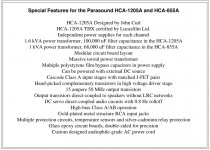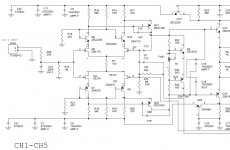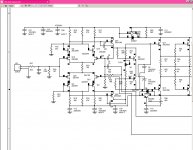Exchange views, by all means, but shutting it down, is that wise?

Repeated violation of forum rules is what causes the shut down not the value (or lack of) of a proposed idea whether it is thought of being new, radical, revolutionary ect.
diyAudio Rules
Now I can hardly understand why something like this should somehow be viewed as heretical or whatever. I mean, this is what is happening and why then should we not talk about it? Exchange views, by all means, but shutting it down, is that wise?
Joe, I'm fairly certain the the final SPL output of George's B110 example is relatively flat when driven with an ordinary amplifier. So again maybe you could post a schematic with some values of what you are talking about, focused on actual acoustic output. Just a sealed box woofer for instance, or use George's impedance plot. The plot is very typical, sharp resonance with a 5-6x increase in impedance (at resonance resistance) IME there is not a commensurate 15dB drop in output certainly not with the inverse shape of the impedance.
You continue to describe an essentially empirical process based on things that sound like good ideas (to you).
Last edited:
Or put it in vacuum...
Thanks.
A driver working in vacuum has no acoustic loading.
This is an additional test step (but difficult for an amateur to do it).
But please note that even in vacuum with no acoustic loading of the cone, the motional impedance is still there.
Locking the cone takes it out of the picture.
George
>Edit: Scott, the plots were from a B110, acoustic output is not exemplary flat but this is not the point.As I understand it, Joe is in search of something mysterious hidden in the impedance of a driver.
I assumed JR was just asking if I measured any speakers and that he has done a lot.
Seemed a polite exchange, I had no issues.
A locked rotor measurement would certainly give the static parameters, and show how the masses impact.
It cannot show how flux dragging impacts hf impedances while bass is pushing Xmas though. That would require one heck of a measurement setup.
Jn
Seemed a polite exchange, I had no issues.
A locked rotor measurement would certainly give the static parameters, and show how the masses impact.
It cannot show how flux dragging impacts hf impedances while bass is pushing Xmas though. That would require one heck of a measurement setup.
Jn
The only snag I can think of, is what parameter needs to be optimized.. Acceleration, velocity, or pressure of the air in front of the driver.
Jn
Right. Same question I asked in the beginning which was to the effect, "what is the signal in the recording supposed to represent, velocity, pressure, or what?" The gentleman did not respond.
Don't know if it matters though. Mics that respond to one or the other may both be used in the same recording. Also, don't sound waves more or less alternate between velocity and pressure just as EM waves do with E and M fields (at least once launched into air/matter or space, as the case may be)?
Right. Same question I asked in the beginning which was to the effect, "what is the signal in the recording supposed to represent, velocity, pressure, or what?" The gentleman did not respond.
Don't know if it matters though. Mics that respond to one or the other may both be used in the same recording. Also, don't sound waves more or less alternate between velocity and pressure just as EM waves do with E and M fields (at least once launched into air/matter or space, as the case may be)?
Yah, it's a problem. You can easily get into where do you want it optimized in the sound field. That can go all the way to head in the vice.
Jn
The HCA-855 is not one of my designs. More than 1/2 of Parasound's preamps and power amps are not my designs and I usually have nothing to do with them. They are designed in Taiwan to a price-point.
Than they stealing your design.
Exert from the user manual.
HCA-1205A
HCA-855A
Attachments
Thanks.
A driver working in vacuum has no acoustic loading.
I fixed the B110 reference. You need care thermal management is very different in a vacuum.
Back to headphones, I can't see the nth degree of distortion free reproduction in a room being anything other than academic? Now, when it comes to imagery in a room that can be interesting, probably because it seems so personalThat can go all the way to head in the vice.
You need care thermal management is very different in a vacuum.
We are not there yet 😀
George
I agree with you. However, the academic is really interesting, Joe seems to be thinking about it, and my work-work does seem applicable so I talk on the theory.Back to headphones, I can't see the nth degree of distortion free reproduction in a room being anything other than academic? Now, when it comes to imagery in a room that can be interesting, probably because it seems so personal
My listening preference is either background or full tilt PA.
But yes, imaging is neat.
Jn
with headphones, where Zair is negligible, it's all velocity!
But with headphones you negate the travel 😡
Where's the imagery ? Tricky 😡 ( imagery is in the brain 😛 )
But with headphones you negate the travel 😡
Where's the imagery ? Tricky 😡 ( imagery is in the brain 😛 )
That's MIT for you. It is just like the English Prep Schools that would teach someone 'proper' English usage. They could spend the rest of their lives correcting everyone that they met outside their culture, but it would just be as insulting and wasteful as what is done here. We all know what DC resistance means. It means the impedance that you measure at DC. This separates the resistive component from any added impedance, either inductance, capacitance, or MOTIONAL FEEDBACK from the wire resistance in the voice coil of a specific direct radiator speaker. Quibbling between DC resistance and DC impedance in this case actually just slows down communication.
Yes John, but Joe said the DC resistance "doesn't change with frequency", which is completely meaningless, or did I misunderstand? It wouldn't be the first time, and I am not an engineer, so I don't claim any knowledge beyond grade 12 physics. You seem upset that I mentioned it, maybe you are right. After all, I did understand that he meant the resistive part of the VC impedance, but it just seemed very odd to refer to DC and frequency in the same breath. If it makes you feel better to beat me up for mentioning it, knock yourself out, but please hold Joe to the same standards.
Joe then implied that the resistance of the speaker was the only part of the impedance other than back EMF, which I am pretty sure is flat out wrong. Again, nit an engineer to please feel free to correct me.
JN's analysis was, as usual, concise and complete, but I was going for something much simpler. Joe said if you apply an AC voltage of 6V RMS to a speaker that has a DC resistance of 6 Ohms, then you would expect a current of 1 Ampere in the coil, but that is not true. It would be true if the VC was an ideal resistor, but it is neither ideal nor a resistor. If you took the voice coil out of the speaker, isolated it from magnetic fields, and mounted it in a fixture where it could not move, it still would not act like a resistor, because it's a big honking inductor. It's impedance will rise with frequency, and the current through it will decrease with frequency.
As someone who went to an English Prep school I really don't ever feel the need to correct people from outside my culture, whatever 'my culture' is.
And Yes I know that explains a lot about me 😛
And Yes I know that explains a lot about me 😛
A parting shot..
Seems to me the locked rotor vc inductance should be a function of it's location in the gap. In the extreme, if you push it far in such that all the coil is behind the front plate, the entire magnetic circuit serves for flux, the reluctance is dominated by the gap length and the magnet permeability. If you push it such that it's in front of the front plate, the magnetic circuit does not close the flux loop and the coil is using free air for flux return to the front plate.
Has anybody ever tried measuring this position dependence?
Jn
Seems to me the locked rotor vc inductance should be a function of it's location in the gap. In the extreme, if you push it far in such that all the coil is behind the front plate, the entire magnetic circuit serves for flux, the reluctance is dominated by the gap length and the magnet permeability. If you push it such that it's in front of the front plate, the magnetic circuit does not close the flux loop and the coil is using free air for flux return to the front plate.
Has anybody ever tried measuring this position dependence?
Jn
Back to headphones, I can't see the nth degree of distortion free reproduction in a room being anything other than academic? Now, when it comes to imagery in a room that can be interesting, probably because it seems so personal
If they finally crack the DSP to turn 2 channel stereo into glorious headphone experience or the smyth realiser comes down in price I will be interested. Given that Bob Katz has calibrated a realiser in his mastering suite you could in theory get close to 'as intended'.
I hardly use my headphones. It seems to take the room to create the imagery so I'm not sure it's all in the brain, or rather it's how the brain interprets the sound in the room?with headphones, where Zair is negligible, it's all velocity!
But with headphones you negate the travel 😡
Where's the imagery ? Tricky 😡 ( imagery is in the brain 😛 )
I agree with you. However, the academic is really interesting
It is interesting, from an academic point of view 😉
Have you tried any of the contraptions?If they finally crack the DSP to turn 2 channel stereo into glorious headphone experience or the smyth realiser comes down in price I will be interested. Given that Bob Katz has calibrated a realiser in his mastering suite you could in theory get close to 'as intended'.
The reason headphones don't get the sound out of your head is that it moves with your head. That "breaks" part of the spatial processing that your brain uses to localize sound. The Smyth and some other efforts work to overcome this with sensors and dsp to keep the sounds localized as you move your head.
Its an obvious thing but whenever iI try to pitch it the push back is always: "that's for gamers". However there is a gadget from Waves: Nx – 3D Audio on Any Headphones | Waves that can do some of what the Smyth box does. Of course decent experience also requires a decent headphone. A Stax Lamda Pro is a good choice with serious audiophile pricing.
Its an obvious thing but whenever iI try to pitch it the push back is always: "that's for gamers". However there is a gadget from Waves: Nx – 3D Audio on Any Headphones | Waves that can do some of what the Smyth box does. Of course decent experience also requires a decent headphone. A Stax Lamda Pro is a good choice with serious audiophile pricing.
- Status
- Not open for further replies.
- Home
- Member Areas
- The Lounge
- John Curl's Blowtorch preamplifier part III


